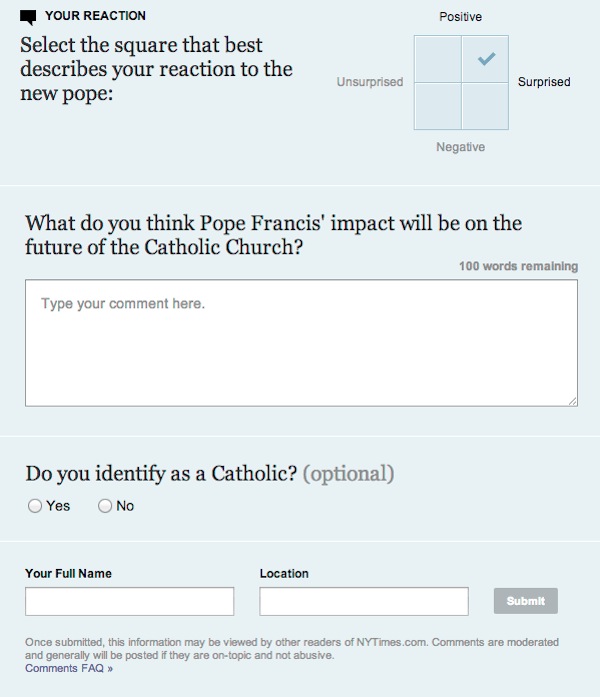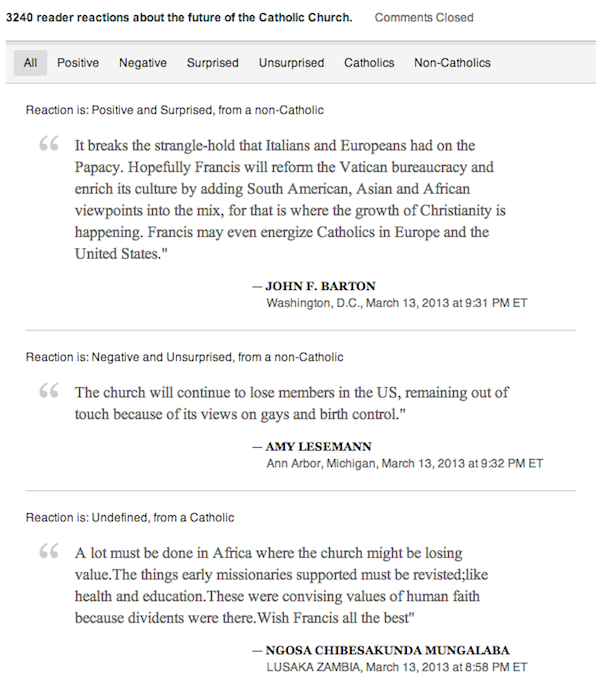

New pope, new approach to online comments for The New York Times. On Wednesday afternoon, as Catholics celebrated the white smoke, the Times rolled out an experimental approach designed to enhance discussion by adding structured data.
Times readers who went to the paper’s story on the election of Pope Francis were asked them to define themselves three ways: Were they happy with the decision or not? Were they surprised by the choice or not? And are they Catholic or not? (They were not asked to declare alignment as lawful good or chaotic evil.)

Those framing questions shape the kind of responses the Times could expect; instead of cutting readers loose at the tail end of an article, it’s asking for a specific reaction — and limiting them to 100 words rather than the normal 800 characters. The new system was also accompanied by a slight design change that added a little more breathing room to individual responses and increased the size of the text. And the new comment metadata meant readers can filter comments by perspective — not unlike how Amazon product reviews separate “helpful” reviews into positive and negative varieties.
The result is something that reads like an edited selection of pullquotes from a magazine rather than walking into the middle of shouting match on a subway platform. But don’t expect to see this as a regular feature. The Times already limits the number of stories it opens up to discussion, and the approach you see on the pope story will probably be more like Grandma’s fine china: reserved for special occasions.
“It’s definitely a case-by-case basis,” said Sasha Koren, the Times’ deputy editor for interactive news. “It’s something for stories we think will get a significant amount of reaction that we can then build something around.”
“It’s a good thing in that it allows us to hone the conversation and guide the conversation a bit more strategically”
Like many newspapers, the Times has its own set of questions and concerns over online comments. The paper employs a rigorous moderation policy, so it’s not just the usual question of tone or decorum — it’s about improving the user experience. Marc Lavallee, assistant editor for interactive news at the Times, said news sites often get caught up in the decision of whether or not to have comments. That seems like such a binary decision because most media companies use a one-size fits all commenting platform, he said. But why can’t comments strategy be better tailored for a story or event? “What we’ve been doing on the newsroom side in the last year or so is build this collection of tools we can reassemble quickly in response to breaking news,” he said.

Some responses in the Times’ new commenting system.
One part of that toolbox focuses on encouraging responses around a predefined set of answers. On the 10th anniversary of the September 11 terrorist attacks, for instance, the Times asked readers where they were on 9/11 and received a flood of responses. They filtered the responses through an interactive map that was equal parts sentiment analysis and data visualization; readers were asked to declare themselves angry, fearful, unmoved, secure, or hopeful, and text analysis filtered the comments further by keywords. Last May, after President Obama announced support for gay marriage, the Times asked readers to chart their response on a defined grid and assembled a data visualization of the results. (It did something similar for Osama bin Laden’s death.) And back in 2008, emotions about Obama vs. McCain turned into a hypnotic data visualization.
Koren said comments, much like data packages or multimedia features, can be a means of creating more value around a story. “People are interested in seeing what others have to say,” Lavallee said. The trick is asking simple questions that won’t impede people from commenting. The pope story received more than 3,200 responses — not a small number, though not record breaking, Koren said. “It’s a good thing in that it allows us to hone the conversation and guide the conversation a bit more strategically,” she said.
Giving comments a shorter, structured nature meant moderators could approve responses quicker, Lavallee said. On the back end, the system bundles comments and pushes them to moderators, which also helps improve response time, he said. The majority of commenters didn’t have difficulty with the new system and they approved a high percentage of the comments, Lavallee said.
It’s possible one benefit of guiding comments is that it forces readers to put a little more thought into what they want to say. Asking them whether they’re surprised or if their reaction is positive can serve as a helpful nudge, Lavallee said. “Some people knew what they wanted to say, but others it made them think,” he said. “So maybe they considered it more by the time they checked a box.”
Lavallee said they wanted the design to encourage readers to add their thoughts and dive in to what others are saying. Parsing responses into categories tells readers they won’t have to devote too much time to reading comments: “It’s hard to have a sense of doneness on a comment thread that has a thousand comments,” he said.
This is the second new spin on comments the Times has offered up this week, after unveiling its new article page prototype. In the prototype, comments appear to get lifted from the footer to a tab in the right side of the page. (Martin Belam commented on the shift.) If there’s a message in all of this, it’s that the Times takes comments seriously: Koren said there’s an ongoing discussion at the Times about the role they can play for the paper. Rather than focusing on abandoning or replacing comments wholesale, she said they want to discover new ways to highlight what people are talking about and find the right architecture for reader interaction.
Photo by Catholic Church of England and Wales used under a Creative Commons license.